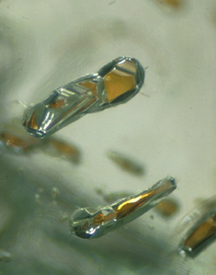 Mineral
impurities in a diamond may decrease the gem’s value for jewelers, but
for geologists they can prove to be priceless: South African diamonds containing
garnet have recently provided evidence that very deep diamonds can form from
surface materials, including carbon from dead organisms buried on the seafloor,
rather than solely from materials located deep within the planet.
Mineral
impurities in a diamond may decrease the gem’s value for jewelers, but
for geologists they can prove to be priceless: South African diamonds containing
garnet have recently provided evidence that very deep diamonds can form from
surface materials, including carbon from dead organisms buried on the seafloor,
rather than solely from materials located deep within the planet. Diamonds with garnet inclusions (shown here) containing a mineral called majorite can form at depths up to 500 kilometers below the surface, and scientists now say that the diamonds may have an organic source from the surface of Earth. Courtesy of Jeff W. Harris, University of Glasgow.
Diamonds provide one of the few means geologists have to obtain direct information about the chemical and mineralogical composition of Earth’s inaccessible mantle. Normally, diamonds form in a “stability zone” within the upper mantle at depths of 150 to 200 kilometers, where the temperature and pressure allow carbon from mantle rocks to stably transition to diamond. The diamonds are then brought to the surface via vertical magmatic columns called kimberlite pipes.
However, in recent decades, some rare diamonds have been found with garnet inclusions containing a silica-rich mineral called majorite that only forms below 250 kilometers. Majoritic garnets, acting as depth gauges, revealed that some diamonds can form at depths up to 500 kilometers. But how the carbon got to such depths remained unknown.
To answer the question, diamond geologist Ralf Tappert of the University of Alberta in Edmonton, Canada, and his colleagues analyzed the composition of deep diamonds collected from the Jagersfontein diamond mine in South Africa by the DeBeers mining company, which partially funded the research and owns the mine. Tappert’s team reports in the July Geology that the garnet inclusions exhibit anomalous values of the element europium — values that are more consistent with shallow crustal rock rather than deep mantle rock.
Additionally, they found the diamonds themselves to have unusually “light” carbon isotope signatures. Because plants and animals preferentially use the lighter carbon-12 isotope, a light carbon isotope ratio could indicate a potential organic source of carbon.
The team therefore concluded that the diamonds formed very deep within Earth, but from surface materials, including the detritus of ocean organisms, brought down by subduction of basaltic oceanic crust. “The thing to keep in mind is that the europium anomalies are from the garnet and the carbon isotope [data] are from the host diamond, but they match,” Tappert says. “This is the surprising thing — that they both give a crustal signature.”
The finding has implications for the study of plate tectonics, mantle geochemistry and the carbon cycle, as it provides evidence for a pathway by which surface carbon could be conveyed through the deep mantle and back to the surface. “I think it’s really important because it shows that such deep recycling is a possible process,” says Steven Shirey, a geochemist at the Carnegie Institution of Washington. “Tracing that return flow is a very exciting aspect of it.”
Tappert says that further research is needed to rule out whether any inorganic processes could produce isotopic signatures that could be mistaken for organic ones — an ongoing and pervasive question within the geological and biological sciences.
However, Shirey says that so far, the inorganic processes suggested have been “a little more speculative.” But Tappert’s argument “focuses on a recognition that the signature you see in the diamond is one that is typical of what happens in shallow levels in the oceanic crust,” Shirey adds. “And that’s a fair argument.”
Additionally, he says that if the combination of signatures could eventually be established as either organic or inorganic, the finding might help, for example, astrobiologists determine whether the origin of any isotopically light carbon ratio found on other planets was organic or primordial. “It gives you some hope that you might be able to see a tracer of ancient life whose signature would have been stored in the deep planet by some earlier process,” Shirey says, adding that such a find would also be evidence that the planet was once tectonically active.
Tappert says the next step would be to see if diamonds from other ultradeep deposits exhibit the same pattern of signatures. However, such ultradeep diamonds are extremely rare — only 100 diamonds containing majoritic inclusions have been found worldwide.

